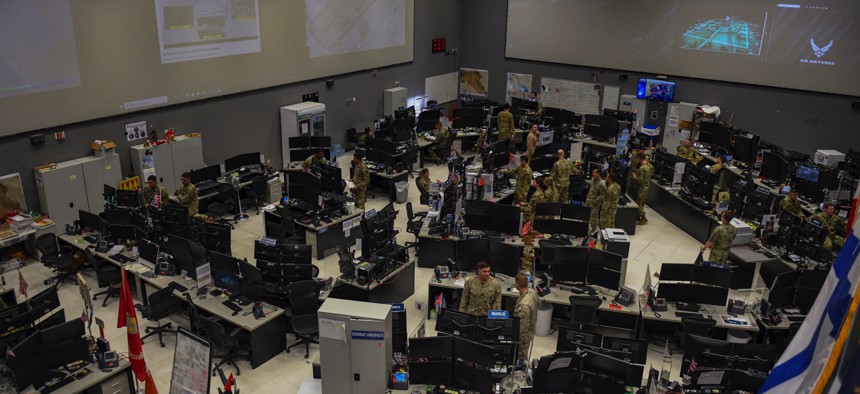
Located at Al Udeid Air Base, Qatar, the U.S. Air Force's Combined Air Operations Center controls air assets in U.S. Central Command's area of responsibility, a 21-nation region from northeast Africa across the Middle East to Central and South Asia. U.S. Air Force / Staff Sgt. Jessica Montano
Effort to build common Mideast air picture gets a ‘B-minus’ from USAF official
“Slow but steady progress” cited by deputy commander of Air Forces Central Command.
DUBAI, UAE—The U.S.-led effort to develop a common air-threat picture in the Middle East gets a “B-minus” for its “slow but steady progress,” Air Force Central Command’s second-in-charge said Sunday.
As threats rise to U.S. forces in the region, AFCENT is leading allies and security partners in developing a “shared, common operating picture and shared threat-warning” display, said Deputy Commander Brig. Gen. David Mineau.
“How are we doing? I'd say B-minus,” Mineau said at the Dubai International Air Chiefs' Conference, a gathering of air power leaders ahead of the Dubai Air Show this week.
Mineau filled in at the conference for his boss, AFCENT leader Lt. Gen. Alex Grynkewich, who was called away on “last-minute business.”
Mineau and other leaders at the conference carefully avoided discussing the Israel-Gaza war blazing on the region’s western edge, one of several hot spots drawing AFCENT’s attention. Iran-backed militia have been attacking U.S. bases and facilities in Iraq and Syria, injuring more than 50 U.S. personnel, and an MQ-9 drone was recently shot down off the coast of Yemen by Houthi forces. And Russian warplanes have become “increasingly bellicose” over Syria, as Grynkewich put it earlier this year.
Building a shared image of the battlespace in the Middle East is crucial because threats “go across boundaries,” Mineau said. The command is integrating its operations and strategy and planning efforts with 17 partners at the Combined Air Operations Center in Al Udeid Air Base, Qatar, he said.
But before a common operating picture can be delivered, Mineau said they need the right policies in place to share information. AFCENT is looking at two possible approaches, he said. One is putting data into a central hub that would hide the source of the information—making the data “anonymous.”
“Or do we get to the point where we can trust each other to know where the data is coming from? So we're working on both of those angles across, again, a common operating picture and intelligence,” Mineau said. There’s a “long way to go on policy, trust-building, but we are making incremental improvements.”
The Air Force is using artificial intelligence to tackle another perennial problem: sifting heaps of data collected by the service’s intelligence assets and other systems. Mineau said leaders have used AI algorithms to suggest various courses of action.
“We are actually getting to where we can have the algorithms present us with packaging options from which to build the master air attack plan and eventually put out an air tasking order for us to execute,” Mineau said.
The general stressed that AI won’t be making the decisions, just organizing options so AFCENT can be “better and quicker,” he said.
No matter how good the technology is, Mineau said, “we need airmen, we need guardians” to control AI.
Mineau spoke ahead of the Dubai Air Show, where major defense contractors will meet to discuss international partnerships and deals and show off new systems.
U.S. military leaders in the region have been instructed not to speak with members of the media this week, but the Air Force will “still offer robust aircraft participation in the show,” according to an AFCENT spokesperson.


